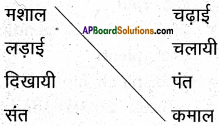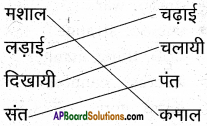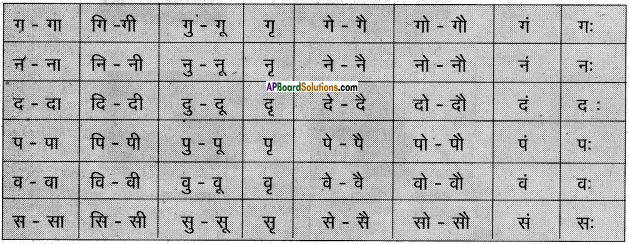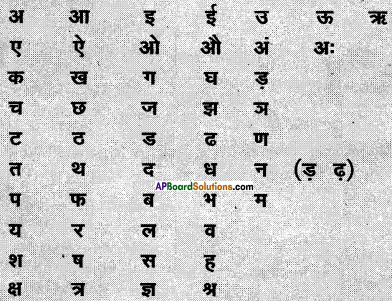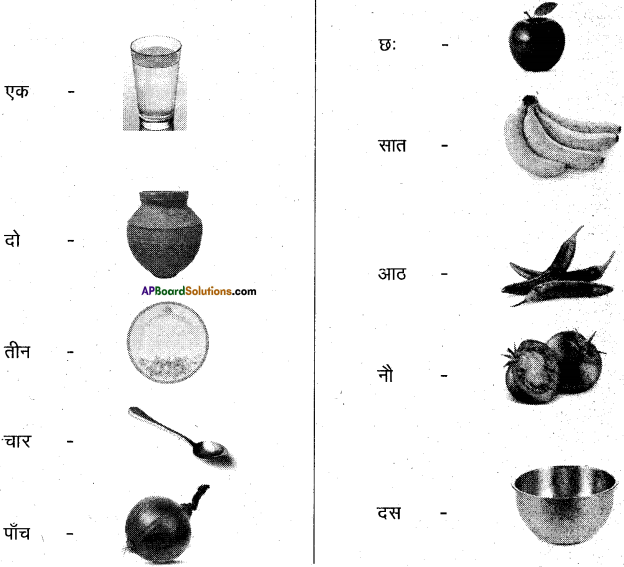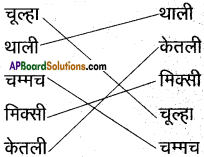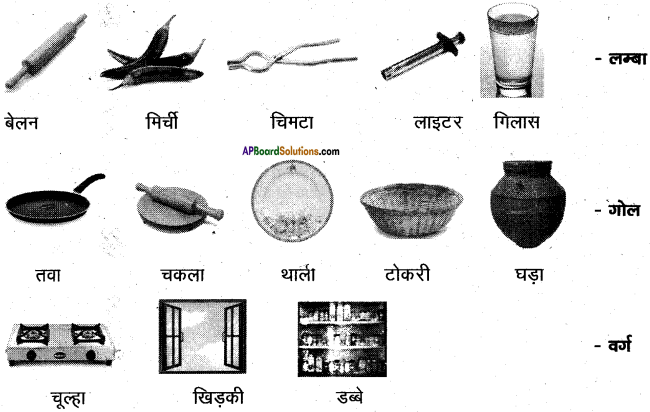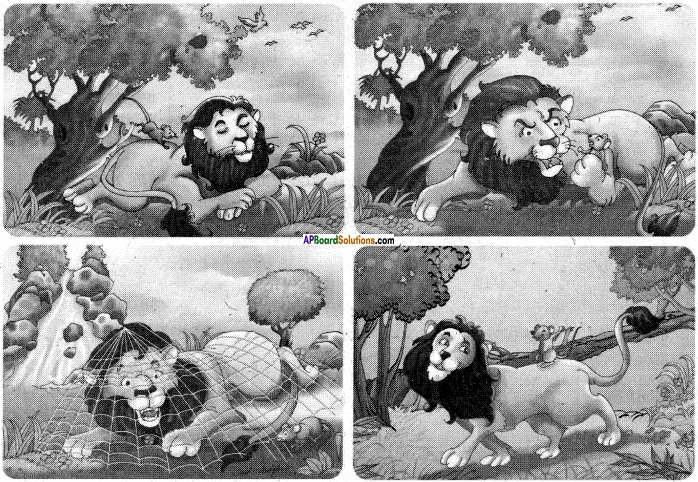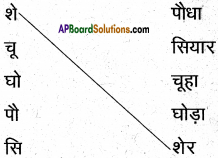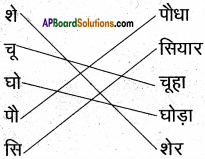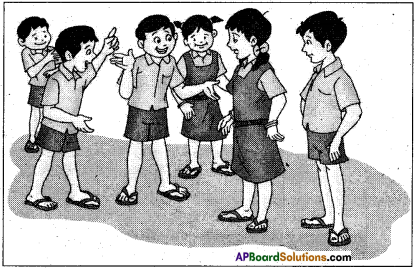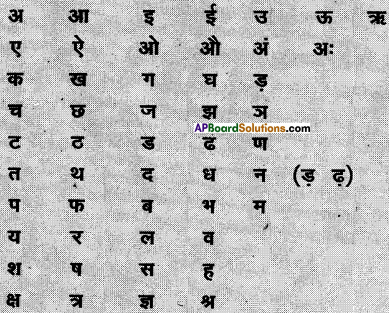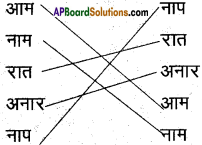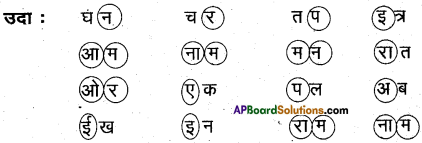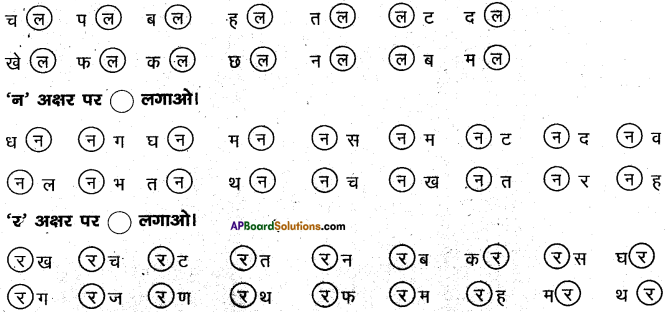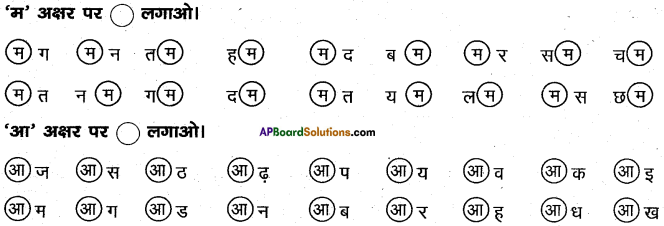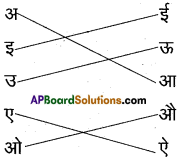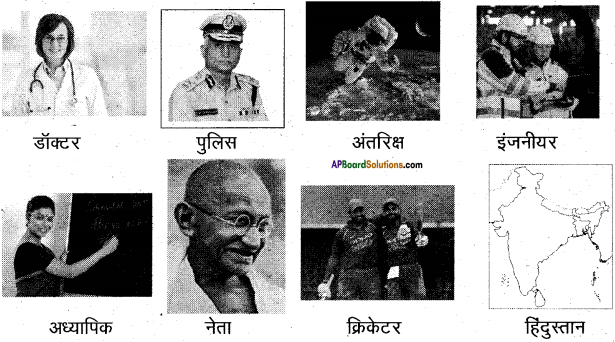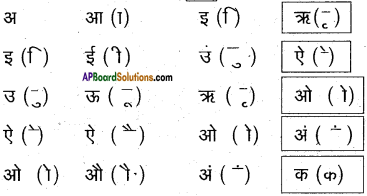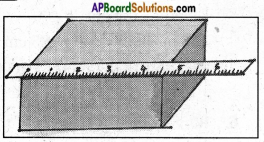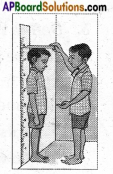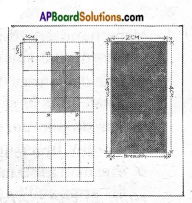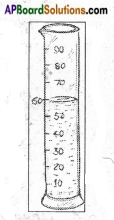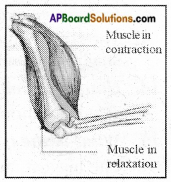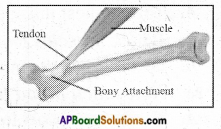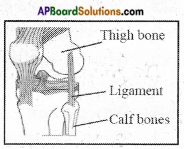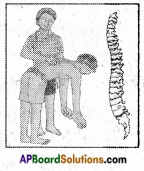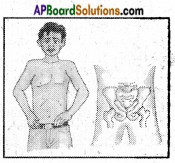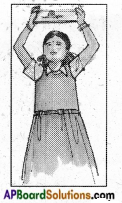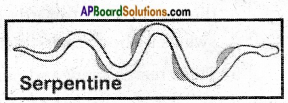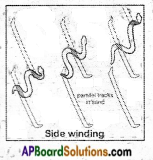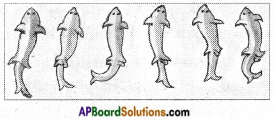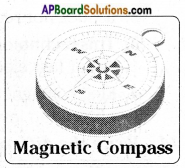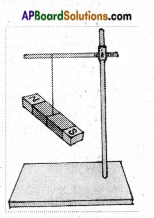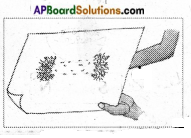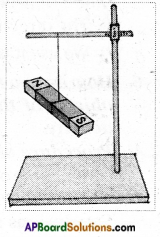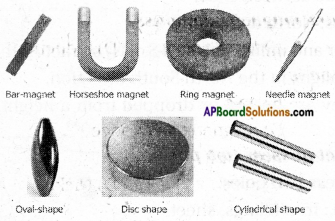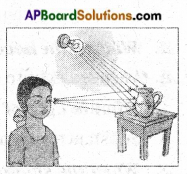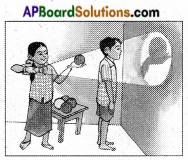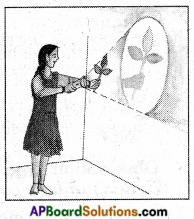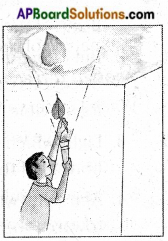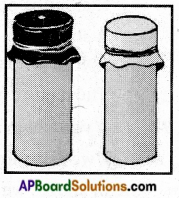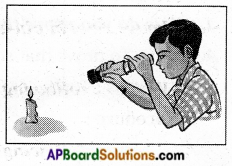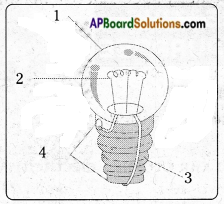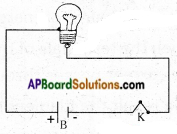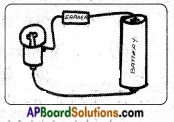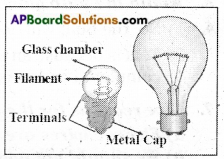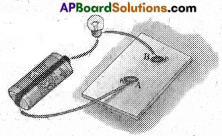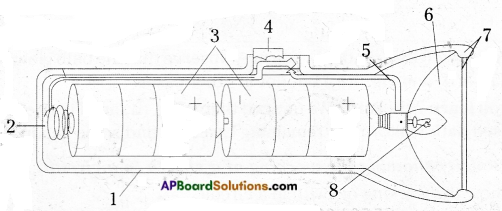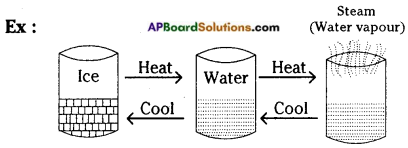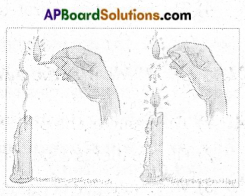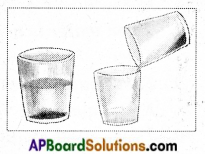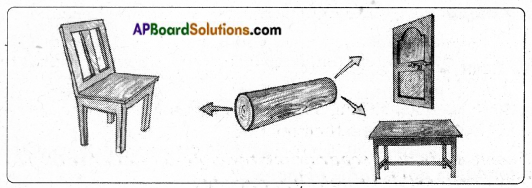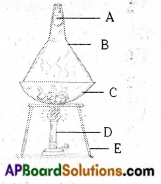AP State Syllabus AP Board 6th Class Hindi Textbook Solutions Chapter 3 ऊँट चला Textbook Questions and Answers.
AP State Syllabus 6th Class Hindi Solutions Chapter 3 ऊँट चला
6th Class Hindi Chapter 3 ऊँट चला Textbook Questions and Answers
Improve Your Learning
सुनिए-बोलिए
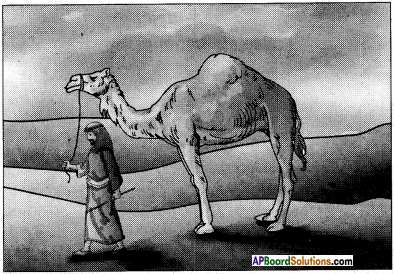
प्रश्न 1.
गीत के बारे में बातचीत कीजिए। (గీతమును గూర్చి సంభాషించండి.)
उतर:
एक ऊँट चल रहा है। वह हिलता डुलता चल रहा है। वह बड़ा ऊँचा ऊँट है। हे भाई ऊँट चल रहा है। ऊँट बालू में भी चलता है। वह बोझ ढोता है। उसे ऊँची पीठ और ऊँची गर्दन है। भाई ऊँट चल रहा है।
प्रश्न 2.
पाठ के चित्र में क्या – क्या हैं? (పాఠ్య చిత్రంలో ఏమేమి ఉన్నాయి?)
उतर:
पाठ के चित्र में एक ऊँट है। एक अरब सेठ ने ऊँट को ले जा रहा है।

प्रश्न 3.
ऊँट के बारे में आप क्या जानते हैं? (ఒంటి గురించి మీకు ఏమి తెలియును?)
उतर:
ऊँट ऊँचा होता है। इसकी गर्दन ऊँची है। इसका पीठ भी ऊँचा है। ऊँट को रेगिस्तान का जहाज कहते हैं। यह कई दिन पानी के बिना रेगिस्तान में चल सकता है।
शिक्षण बिंदु (घ च छ ट ड ‘उ – ु’ ‘ऊ – ू’)

शब्दार्थ (అర్థములు) (Meanings)
ऊँट = ఒంటె, a camel
भई = సోదరుడు, a brother
चलना = వెళ్ళుట, నడచుట, to go, to walk
ऊँचा = ఎత్తైన, high
बालू = ఇసుక, sand
बोझ = బరువు, load
ढ़ना = మోయుట, to carry, to transport
गर्दन = మెడ, neck
पीठ = వీపు, back
हिलना = కదులుట, to move
डुलना = ఇటు – అటూ, todip
इतना = ఇంత, so, so much
उठाना = ఎత్తుడు, to lift
मात्रा जोडो। लिरवो।

पहचानिए और बोलिए। (గుర్తించండి, చెప్పండి.)
उमरा = ధనవంతుడు, aristocrat
ऊन = ఊలు, wool
चामर = వింజామర, corymb
डाली = చెట్టు కొమ్మ, a branch of a tree
खिडकी = కిటికీ, window
कुसुम = పువ్వు, పుష్పము, flower
मूली = ముల్లంగి, radish
सुई = సూది, a needle
आलू = బంగాళదుంప, potato
लडका = బాలుడు, a boy
डमरू = డమరుకం, tabor
कछुआ = తాబేలు, a tortoise
चूडी = గాజు, bangle
नीचे दिये गये बक्से में ‘ू’ और ‘ु’ मात्रा के अंतर को पहचानते हुए पढ़ो

अन्य शब्द (ఇతర శబ్దములు)
उर = ఛాతీ, chest
चुटकी = తొడపాశం పెట్టు, pinch or nip
खुर = గిట్ట, colven hoof
छुरी = చాకు, knife
सुई = సూది, needle
घूस = లంచం, birbe
घुटना = మోకాలు, knee
टुकडा = ముక్క, piece
ऊन = ఊలు, wool
टूक = ముక్క, bluntly, piece
मूली = ముల్లంగి, radish
चूना = సున్నం, lime
डमरू = డమరుకం, tabor
चूडी = గాజు, bangle
खुन = రక్తం, blood
डाकू = దొంగ, robber

अंतर पहचानिए (తేడాలను గుర్తించండి )
चुक = సహాయక క్రియ, helping verb ; चूक = తప్పు, mistake
सुर = దేవత, god ; सूर = వీరుడు, శూరుడు, warrior
टुक = కొంచెం, a little ; टूक = ముక్క, a piece
धुल = దుమ్ము, dust wash ; धूल = దుమ్ము, ధూళి, dust
धुम = తిరుగు, to move ; धूम = తిరుగు, to move
कुल = కులం, వంశం, race, caste ; कूल = ఒడ్డు, riverbank
जुट = అనేక వస్తువుల సమూహం, gather ; जूट = కేశములు, జుట్టు, jute
लुट = దోచుకొను, rob ; लूट = దోచుకొను, robbery
निम्न अक्षरों को पढ़िए और बोलिए। (క్రింద ఇవ్వబడిన అక్షరములను చదవండి, చెప్పండి)
1. घ(ఘ) 2. च (చ) 3. छ (ఛ) 4. ट (ట) 5. ड (డ) 6. उ (ఉ) 7. ऊ (ఊ)
बालगीत
ऊँट चला, भई ऊँट चला
हिलता डुलता ऊँट चला
इतना ऊँचा ऊँट चला
ऊँट चला, भई ऊँट चला।
बालू है, तो होने दो
बोझ ऊँट को ढोने दो।
ऊँची गर्दन, ऊँची पीठ
पीठ उठाए ऊँट चला।
బాలగీతం
ఒంటె వెళ్ళింది, సోదరా ఒంటె వెళ్ళింది
ఇటు అటు కదులుతూ ఒంటె వెళ్ళింది
ఇంత పెద్ద ఎత్తున ఉన్న ఒంటె వెళ్ళింది
ఒంటె వెళ్ళింది, సోదరా ఒంటె వెళ్ళింది
ఇసుకైతేనేమి? అవనీయండి,
ఒంటెను బరువు మోయనీయండి.
ఎత్తైన మెడ, ఎత్తైన వీపు.
వీపు ఎత్తుకుని ఒంటె వెళ్ళింది.
Rhyme in English
The camel went away, brother, the camel went away
Moving hither and thither the camel went away
The camel that is quite tall went away
The camel went away, brother, the camel went away.
What if it is sand? Let it be,
Let the camel carry the burden.
Longer neck, larger hump.
Raising its hump the camel went away.
पढ़िए (घ च छ ट ड ‘उ – ु’ ‘ ‘ऊ – ू’)
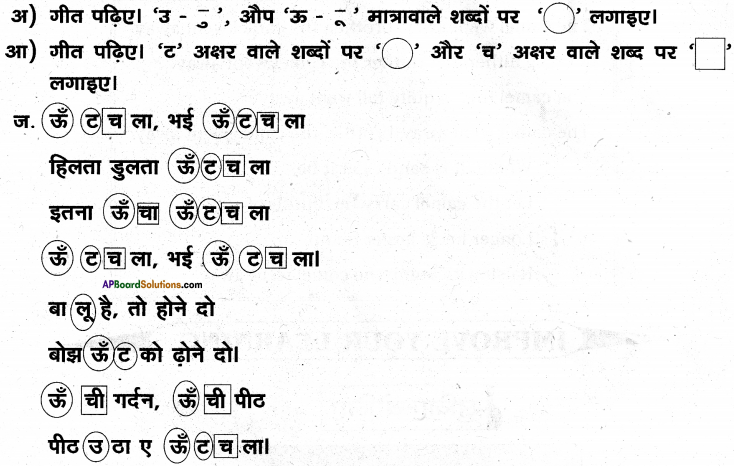
इ) चित्र देखिए। शब्द पढ़िए। इनके अक्षर वर्णमाला में पहचानिए ‘O’ लगाइए।
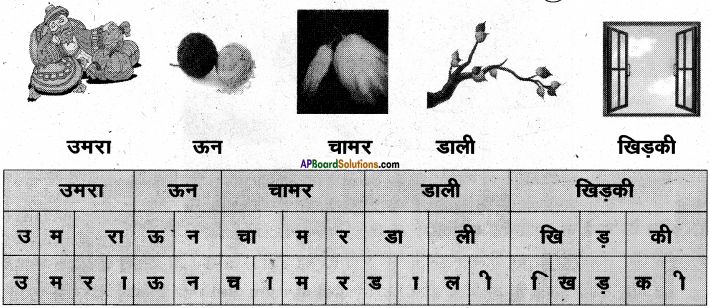

ई) चित्र देखिए। पढ़िए।
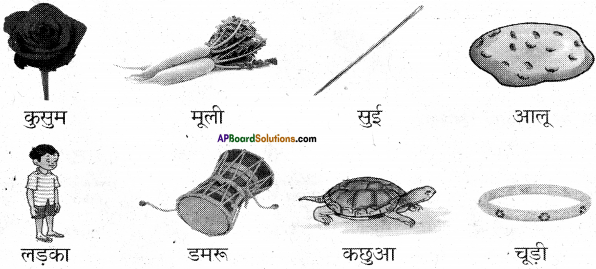
उ) पढ़िए। अंतर समझिए।
चुक – चूक
सुर – सूर
टुक – टूक
धुल- धूल
घुम-घूम
कुल – कूल
जुट – जूट
लुट – लूट
चुक = సహాయక క్రియ, helping verb ; चूक = తప్పు, mistake
सुर = దేవత, god ; सूर = వీరుడు, శూరుడు, warrior
टुक = కొంచెం, a little ; टूक = ముక్క, a piece
धुल = దుమ్ము, dust wash ; धूल = దుమ్ము, ధూళి, dust
धुम = తిరుగు, to move ; धूम = తిరుగు, to move
कुल = కులం, వంశం, race, caste ; कूल = ఒడ్డు, riverbank
जुट = అనేక వస్తువుల సమూహం, gather ; जूट = కేశములు, జుట్టు, jute
लुट = దోచుకొను, rob ; लूट = దోచుకొను, robbery
ऊ) पढ़िए – समझिए।

चल – चलना
हिल – हिलना
डुल – डुलना
उठ – उठना
घूम – घूमना
टूट – टूटना
चला = నడుచు, walk
चलना = నడుచుట, walking
हिल = కదలు, move
हिलना = కదలుట, moving
डुल = కదలు, dip
डुलना = కదలుట, to dip
उठ = లేచు, stand
उठना = లేచుట, standing
घूम = తిరుగు, to move
घूमना = తిరుగుట, moving
टूट = విరుగు, break
टूटना = విరుగుట, to break

लिखिए
अ) सूचना के अनुसार लिखिए।

आ) लेखन अभ्यास
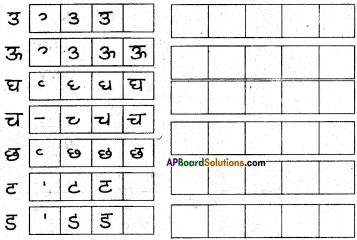
इ) मात्राएँ जोडकर लिखए।

ई) खाली जगह भरिए।

उ) चित्र को देखकर सही अक्षर क्रम में लिखिए।


ऊ) इन वर्गों और मात्राओं से शब्द बनाइए।

उतर:
1. आईना
2. मकर
3. कलम
4. अनार
5. ऊखली
6. घास
7. नमक
8. अमर
9. मच्छर
10. ईख
11. इमली
12. इनाम
13. आराम
14. ऊन
15. नमन
सृजनात्मकता
रंग भरिए। नाम लिखिए।

सुनिए-बोलिस

प्रश्न 1.
पाठ के चित्र में आदमी कैसे दिखाई दे रहा है?
उतर:
पाठ के चित्र में अरब देश का आदमी दिखाई दे रहा है।
प्रश्न 2.
ऊँट ज्यादा कहाँ दिखाई देते हैं?
उतर:
ऊँट ज्यादा रेगिस्तान में दिखाई देते हैं।
प्रश्न 3.
आपने कभी ऊँट को देखा है?
उतर:
हाँ, मैं ऊँट हमारे गाँव में देखा हूँ। सर्कस और फ़िल्मों में टी.वी में देखा हूँ।

प्रश्न 4.
ऊँट के बारे में दो पंक्तयाँ बोलो?
उतर:
ऊँट रेगिस्तान में आसानी से चल और दौड़ सकता है, इसलिए इसे रेगिस्तान का जहाज कहते हैं। ऊँट को पसीना नहीं आता है। ऊँट के पीठ पर कूबड़ रहता है। यह बिना पानी पीये अधिक दिन रह सकचा
प्रश्न 5.
रेगिस्तान में ऊँट को किस काम के लिए उपयोग किया जाता है?
उतर:
रेगिस्तान में ऊँट को यातायात के काम के लिए उपयोग किया जाता है।
प्रश्न 6.
क्या आपको ऊँट अच्छा लगता है? क्यों बताओ।
उतर:
हाँ, मुझे ऊँट अच्छा लगता है। क्योंकि वह देखने में संदर, दृढ़ और ऊँचा रहता है। उसके पीठ पर बैठने पर झूलें के समान हिलता है।
प्रश्न 7.
लंबी गर्दन, ऊँची पीठ, बालू में मैं चलता हूँ। कौन हूँ ? मैं कोन हूँ?
उतर:
लंबी गर्दन, ऊँची पीठ, बालू में चलते हो तुम, नाम तुम्हारा ऊँट है।
प्रश्न 8.
ऊँट कहाँ – चल सकता है?
उतर:
ऊँट अधिकतर रेत में चलता है। पहाड़ों में और मैदानों में सड़क पर भी चलता है।
प्रश्न 9.
ऊँट कैसे चलता है?
उतर:
ऊँट हिलते – डुलते चलता है।
प्रश्न 10.
ऊँट किस प्रकार का काम करता है?
उतर:
ऊँट सवारी और सामान ढोने का काम करता है।
प्रश्न 11.
रेगिस्तान में क्या – क्या रहते हैं?
उतर:
रेगिस्तान में ऊँट, रेगिस्तान चीता, लोमड़ी, जंगली कुत्ते, शुतुरमुर्ग, बकरियाँ आदि रहते हैं।
प्रश्न 12.
ऊँट कहाँ चलते हैं?
उतर:
ऊँट बालू में चलते हैं।
प्रश्न 13.
ऊँट का पैर कहाँ नहीं फँसता है?
उतर:
ऊँट का पैर बालू में नहीं फँसता है।
प्रश्न 14.
बालू का अर्थ क्या है?
उतर:
बालू का अर्थ रेत है।
प्रश्न 15.
रेत कहाँ – कहाँ पाये जाते हैं?
उतर:
रेत समुद्र के किनारे, नदी के किनारे और रेगिस्तान में मिलता है।
प्रश्न 16.
बोझ उठाने के लिए किन पशुओं का उपयोग करते हैं?
उतर:
बोझ उठाने के लिए घोड़े, गधे, हाथी, ऊँट, बैल, खच्चर आदि पशुओं का उपयोग करते हैं।

प्रश्न 17.
ऊँची गर्दन किन पशुओं की होती है?
उतर:
ऊँची गर्दन वाले पशु जिराफ़, ऊँट, शुतुरमुर्ग है।
प्रश्न 18.
ऊँट कहाँ ज्यादा हिलता – डुलता चलता है?
उतर:
ऊँट रेत में ज्यादा हिलता – डुलता चलता है।
प्रश्न 19.
ऊँट की क्या विशेषता है?
उतर:
ऊँट ऊँचा रहता है, बोझ ढोता है। ऊँची गर्दन, ऊँची पीठ होती है। बालू में चलता है।
प्रश्न 20.
हमारे देश में ऊँट ज्यादा कहाँ पाये जाते हैं?
उतर:
हमारे देश में ऊँट ज्यादा राजस्थान में पाये जाते हैं।
प्रश्न 21.
ऊँट क्या खाता है?
उतर:
ऊँट शाखाहारी पशु है। हरे पत्ते, मूंग, हरी घास, कटीली झड़ी आदि खाता है।
प्रश्न 22.
ऊँट पानी कहाँ जमा करके रखता है?
उतर:
ऊँट पानी अपने कूबड़ में जमा करके रखता है।
प्रश्न 23.
ऊँट एक बार में कितना पानी पी सकता है?
उतर:
ऊँट एक बार 100 – 150 लीटर पानी पी लेता है।
प्रश्न 24.
उंटनी का दूध कैसा होता है?
उतर:
उंटनी के दूध में पानी, वसा और प्रोटीन होते हैं।
प्रश्न 25.
ऊँट की अधिकतम भागने की गति कितनी है?
उतर:
ऊँट की अधिकतम भागने की गति 65 किमी प्रति घंटा के आसपास होती है।
पढ़िए
समरुपी अक्षरों को मिलाओ।
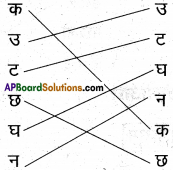
हर पंक्ति के चित्र देखो और पहचानो जो चित्र समूह से अलग है, उस पर (✗) लगाओ।

बायी ओर दिए गए वर्ण/मात्रा को शब्दों में ढूँढो और O लगाओ।
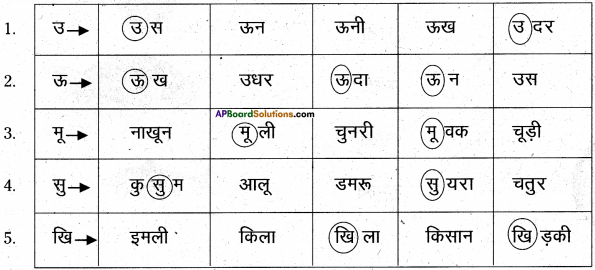
पढ़ो और जोड़ो
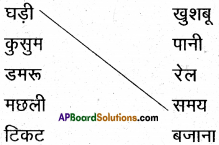
उतर:
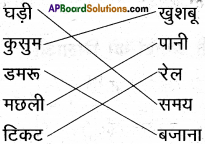

चित्रों को दिए गए नामों से मिलाओ।
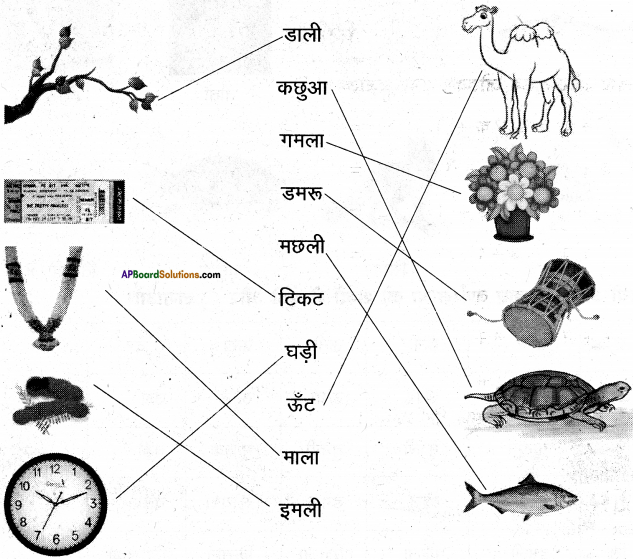
तुक वाले शब्दों को रेखा से मिलाओ।

लिखिए
अक्षर और मात्रा जोड़कर शब्द बनाओ।
1. ि + ख + इ + क + ी = खिड़की
2. च + ु + ट + क + ी = चुटकी
3. ट + ु + क + ड़ + ा = टुकड़ा
4. ि + क + स + ा + न = किसान
5. ि + त + त + ल + ी = तितली
6. म+ न + ा + न + ा = मनाना
7. अ + ा + र + + म = आराम
चित्र देखकर उनके नाम लिखिए।

नीचे दिए गए शब्दों में उचित स्थान पर ‘ई’ और ‘ऊ की मात्रा लगाइए और नये शब्द बनाइए।
1. मन – मीना
2. मुल – मूली
3. डाक – डाक
4. पठ – पीठ
5. चना – चूना
6. गत – गीत
7. कला – कीला
8. नम – नीम
9. मली – मूली
10. डमर – डमरू

नीचे दिए गए शब्दों के मात्रा निकालकर नये शब्द लिखिए।
1. तीन – तन
2. कुल – कल
3. कुसुम – कसम
4. बालू – बाल
5. कमरा – कमर
6. नीली नल
7. मोर – मर
8. खेल – खल
9. कमाल -कमल
10. जाल – जल
नये शब्द बनाओ।
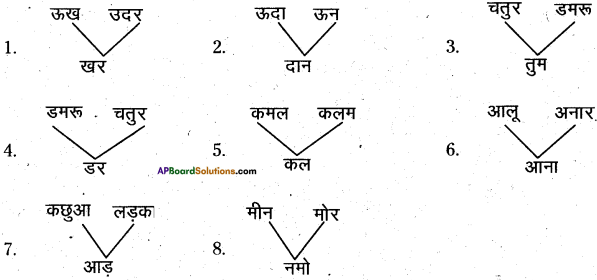
निम्न अक्षरों का उपयोग करके पहेलियाँ बनाइए।

‘आ – ा’, इ – ि, ‘उ – ु’, वाले शब्द चयन करके लिखिए।

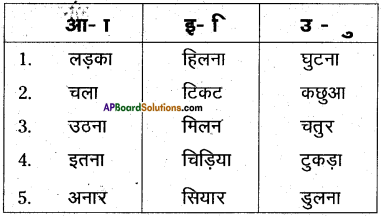
कुत्ता, शेर, ऊँट, बकरी, सियार, बिल्ली, खरगोश, घोड़ा, बाघ, चीता, हाथी, भेड़, तोता, साँप, गाय, गधा, रीछ, भालू।
| पालतू जानवर |
जंगली जानवर |
| कुत्ता |
शेर |
| तोता |
सियार |
| गाय |
चीता |
| गधा |
हाथी |
| बिल्ली |
रीछ |
| ऊँट |
भालू |
| घोड़ा |
बाघ |
| बकरी |
खरगोश |
| भेड |
साँप |

इन्हें – पढ़ो – इन वर्गों और मात्राओं से शब्द बनाओ।
घ च छ ट ड उ ु ऊ ू क ख ल स न म र
अ आ । इ – ि ई – ी
अमर रईस समर रसम मकर
रखना नाटक कलाई सड़क खनिक
कलसा सखी खीर लचीला लालच
चमकनी नीचा चालू कीड़ा डाली
लीन घड़घड़ टिकट राई इलिका
आम अनार ईख आघ चडतरा

इन शब्दों को अकारादि क्रम में लिखिए।
अनार कलाई चालू नीचा लचीला
अमर कलसा चडतरा मकर लालच
आघ कीड़ा चमकनी रईस लीन
आम खनिक टिकट रसम समर
इलिका खीर डाली रखना सड़क
ईख घड़घड़ नाटक राई साखी
अक्षरों को सही क्रम में रखकर शब्द बनाइए।
1. ता + ज + ग + र = गरजता
2. शा + ठ + ला + पा = पाठशाला
3. गी + बा + त + ल = बालगीत
4. छु + क + आ. = कछुआ
5. रु+ ल + मा = रूमाल
6. डा + टु + का = टुकड़ा
7. का + ल + ड़ = लड़का
8. र + ना + अ = अनार
9. सा + न + कि = किसान
10. त + ली + ति = तितली

पढ़ो – समजो – लिखो
आलू टमाटर प्याज़ गाजर मूली
खीरा बीन्स पत्ता गोभी मशरूम फूल गोभी
भिंड़ी शिमला मिर्च लौकी करेला चुकंदर
पेठा अरबी कुम्हडा कदू जिमीकंद कच्चा केला
खाली स्थान में चित्र देखकर शब्द लिखए।
मूली चूड़ी नीम कछुआ किसान
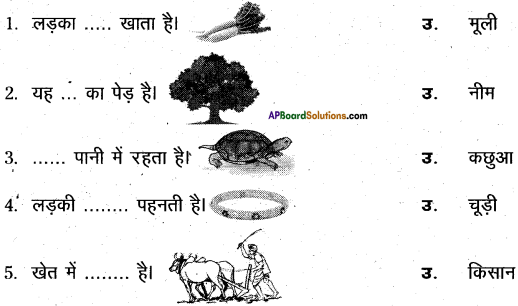
अधूरे शब्दों को ‘ल’ से जोड़कर लिखिए।

दो और चार अक्षर वाले शब्द बनाइए।
घ र क स अच छ न त प थ म ट व
| दो अक्षर वाले शब्द |
चार अक्षर वाले शब्द |
| घर |
अचकन |
| कम |
थरमस |
| सर |
कसरत |
| छत |
वनचर |
| तप |
टमटम |
खाली स्थान में सही शब्द भरिए।
1. मीना ………. तितली आयी मिलकर देखें। (आ/जा)
उतर:
आ
2. अनार …….. दाना लाल है। (खा/का)
उतर:
का
3. एक ….. था। (कौआ/खोवा)
उतर:
कौआ
4. ….. पुराना है। (किला/कीला)
उतर:
किला
5. सड़क पर …….. आ| (घुम/घूम)
उतर:
घूम
इन्हें पढ़िए – लिखिए।
इन वर्गों और मात्रा वाले शब्दों को
अ, आ, न, म, र, इ, ई, क, ख, ल, स, उ, ऊ, च, छ, घ, ट, ड, ा, ि, ी, ु, ू
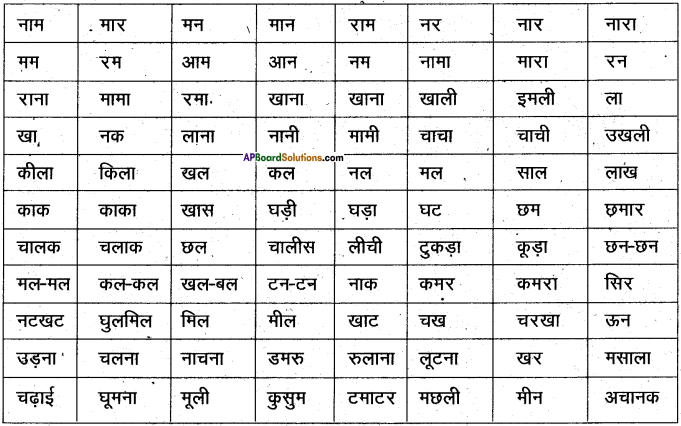
सही अक्षर पर ‘ऊ – ू’ की मात्रा लगाइए। नया शब्द बनाइए।
बाल – बालू
सट – सूट
चना – चूना
चाक – चाकू
कल – कूल
डाक – डाकू
नर – नूर
कड़ा – कूड़ा
लट – लूट
मल – मूल
डमर – डमरू

चित्र पहचानकर सही शब्द पर गोला ‘O’ लगाइए।
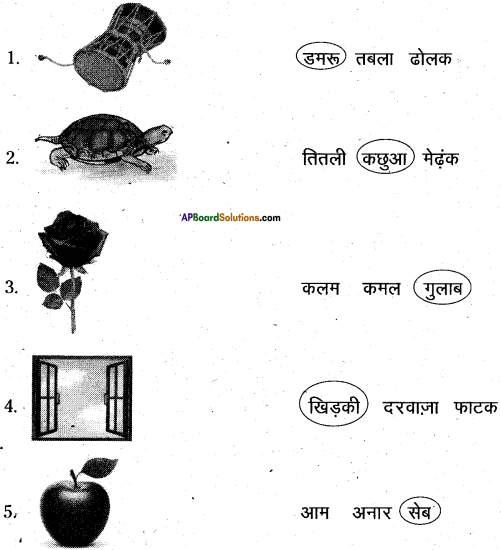
शब्दों के साथ गोले में लिखा शब्दांश मिलाओ और नये शब्द बनाओ।
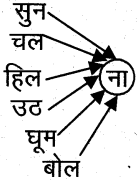
उतर:
सुनना
चलना
हिलना
उठना
घूमना
बोलना
भाषा की बात
विलोम शब्द (उल्टे शब्द)
चलना × रुकना
उठाना × बैठाना
इतना × ‘उतना
ऊँची × नीची
पर्यायवाची शब्द
ऊँट – उष्ट्र, लंबोष्ठ, शुतुर
बोझ – भारण, भार, भर
गर्दन – कण्ठ, गला, ग्रीवा
भई – भाई, भ्राता, अनुज

अंतर समझिए। (एक – अनेक)
ऊँचा – ऊँचे
चला – चले
इतना – इतने
हिल – हिले
डल – डुले
शब्द पढ़िए और सुंदर अक्षरों में लिखिए।

| क्या मैं ये कर सकता हूँ? |
हाँ (✓) |
नहीं (✗) |
1. चित्र के बारे में बातचीत कर सकता हूँ।
गीत गा सकता हूँ। |
✓ |
|
2. ‘घ, च, छ, ट, ड, उ, ऊ’ अक्षरों से बने शब्द पढ़ सकता हूँ
बिना देखे लिख सकता हूँ। |
✓ |
|
| 3. चित्र में रंग भर सकता हूँ। |
✓ |
|
फलों के नाम (పండ్ల పేర్లు)
देखिए समझिए।

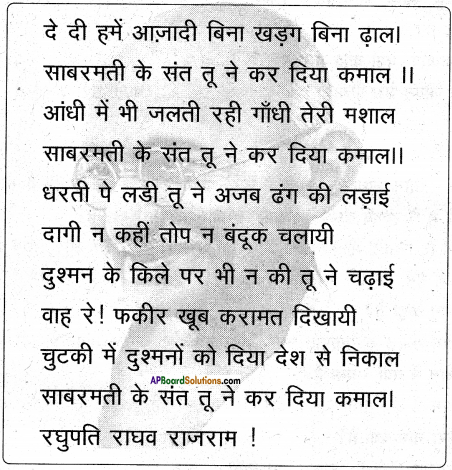
![]()
![]()
![]()
![]()


